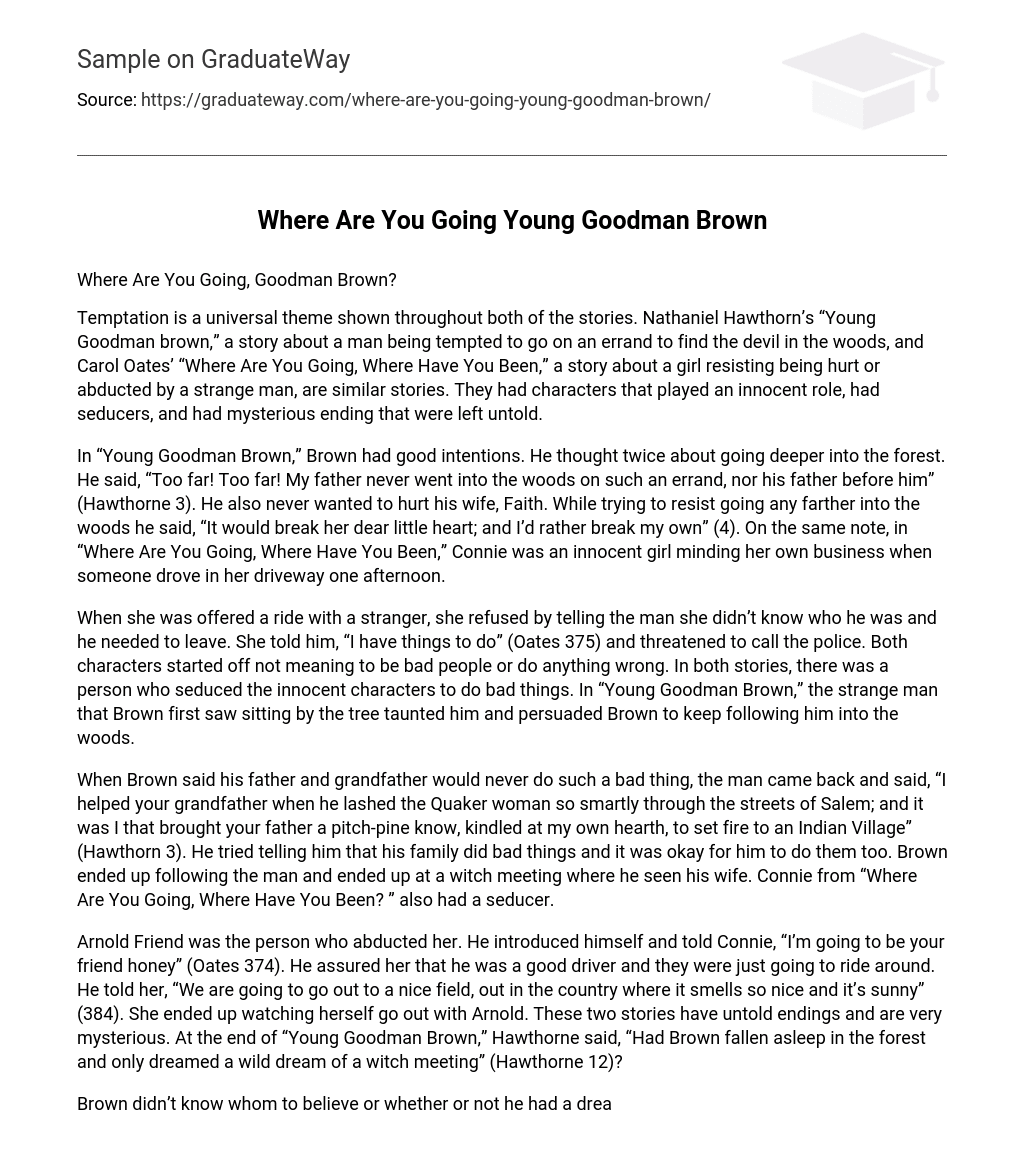Where Are You Going, Goodman Brown?
Temptation is a universal theme shown throughout both of the stories. Nathaniel Hawthorn’s “Young Goodman brown,” a story about a man being tempted to go on an errand to find the devil in the woods, and Carol Oates’ “Where Are You Going, Where Have You Been,” a story about a girl resisting being hurt or abducted by a strange man, are similar stories. They had characters that played an innocent role, had seducers, and had mysterious ending that were left untold.
In “Young Goodman Brown,” Brown had good intentions. He thought twice about going deeper into the forest. He said, “Too far! Too far! My father never went into the woods on such an errand, nor his father before him” (Hawthorne 3). He also never wanted to hurt his wife, Faith. While trying to resist going any farther into the woods he said, “It would break her dear little heart; and I’d rather break my own” (4). On the same note, in “Where Are You Going, Where Have You Been,” Connie was an innocent girl minding her own business when someone drove in her driveway one afternoon.
When she was offered a ride with a stranger, she refused by telling the man she didn’t know who he was and he needed to leave. She told him, “I have things to do” (Oates 375) and threatened to call the police. Both characters started off not meaning to be bad people or do anything wrong. In both stories, there was a person who seduced the innocent characters to do bad things. In “Young Goodman Brown,” the strange man that Brown first saw sitting by the tree taunted him and persuaded Brown to keep following him into the woods.
When Brown said his father and grandfather would never do such a bad thing, the man came back and said, “I helped your grandfather when he lashed the Quaker woman so smartly through the streets of Salem; and it was I that brought your father a pitch-pine know, kindled at my own hearth, to set fire to an Indian Village” (Hawthorn 3). He tried telling him that his family did bad things and it was okay for him to do them too. Brown ended up following the man and ended up at a witch meeting where he seen his wife. Connie from “Where Are You Going, Where Have You Been? ” also had a seducer.
Arnold Friend was the person who abducted her. He introduced himself and told Connie, “I’m going to be your friend honey” (Oates 374). He assured her that he was a good driver and they were just going to ride around. He told her, “We are going to go out to a nice field, out in the country where it smells so nice and it’s sunny” (384). She ended up watching herself go out with Arnold. These two stories have untold endings and are very mysterious. At the end of “Young Goodman Brown,” Hawthorne said, “Had Brown fallen asleep in the forest and only dreamed a wild dream of a witch meeting” (Hawthorne 12)?
Brown didn’t know whom to believe or whether or not he had a dream or it was real. Hawthorne left the ending open for the readers to imagine what happened. In “Where Are You Going, Where Have You Been? ” it said, “She watched herself push the door slowly open as if she were back safe somewhere in the other doorway, watching his body and the head of long hair moving out into the sunlight” (Oates 384). Was Connie dreaming? Or was she so scared that she actually had an out-of-body experience and watched herself walk out of the door with Arnold?
These two stories, “Young Goodman Brown,” and “Where Are You Going, Where Have You Been,” are very similar if the reader pays attention to details. Hawthorne and Oates thought alike when writing these stories. Both stories have a character that is a victim; have a villain, and untold endings to keep the imagination going.
Works Cited
Hawthorne, Nathaniel. “Young Goodman Brown. ” 40 Short Stories. 4th ed. Boston: Bedford/ St. Martin’s 2013. Print. Oates, Carol J. “Where Are You Going, Where Have You Been? ” 40 Short Stories. 4th ed. Boston: Bedford/ St. Martin’s 2013. Print.





